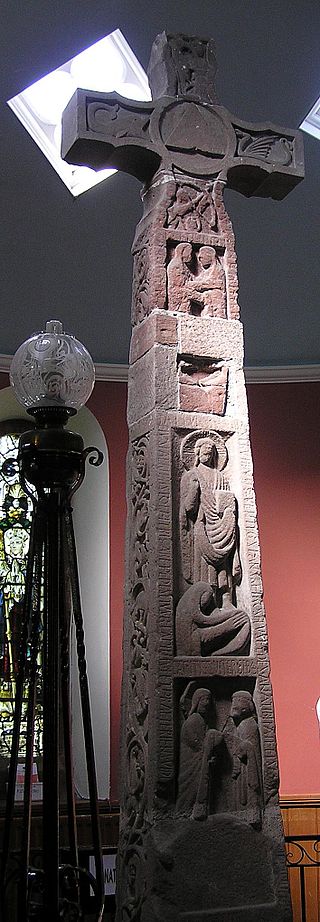
Note: If you wish to receive, via e-mail, (1) my weekly newsletter or (2) daily copies of these posts, notify me at rrbates1951@gmail.com and indicate which you would like. I promise not to share your e-mail address with anyone. To unsubscribe, send me a follow-up email.
Good Friday
Reprinted and revised from April 3, 2015
A remarkable poem in Old English tells the crucifixion story from the cross’s (or rood’s) point of view. Scholar Helena Tampierováne believes that the poem, while obviously Christian, is also rooted in Celtic and Anglo-Saxon veneration of the Tree of Life. Therefore, we see a merging of paganism and Christianity.
Tampierováne quotes medievalist Leeming Fee on the spiritual significance of trees in ancient mythologies:
Thus the tree both exists in this world and seems to transcend it, and therefore may be seen to symbolize the oppositions of life and death and of eternity and transience. Trees are most often associated with life-giving energy, and due to their longevity are quite often thought to be repositories of wisdom: the Egyptian Osiris and the Greek Adonis, as resurrection gods, both are associated with trees, and the Buddha was born again in the wisdom he found under the Bodhi Tree. Sometimes both in the Indic and Norse traditions, a tree is thought to represent life and death on a cosmic scale, symbolizing the full manifestation of the universe.
Of these traditions, I am most familiar with the cosmic tree in Norse mythology (Yggdrasil). One can see various areas of overlap. Odin willingly hangs himself from the tree in order to gain knowledge of other worlds, just as Christ hanging from the cross crossed over into death and then back to life. And the cross, like Yggdrasil, finds itself scarred by the forces of death, yet emerges to be a source of new life.
Like all religions, in other words, Christianity is syncretistic, drawing on local legends in order to provide people with a symbol system that addresses their deep spiritual needs. As Tampierováne sees it, when pre-Christian England encountered missionary stories of the cross, it associated it with its own cultic trees. The tree in the poem regards itself working with Christ, even though they seem to be at odds—just as, a few centuries later, pagan stories about a green man (in Sir Gawain and the Green Knight) sought to to regenerate a Christianity that the poet sensed was becoming static.
Some scholars regard the cross as a loyal retainer, faithful to his lord to the end. But it can also be seen as feminized (“that he might mount upon me”), with the crucifixion working as a marriage of Christ and the church. Regardless of how one sees it, in the end the rood is triumphant:
Now the time has come
That far and wide on earth men honor me,
And all this great and glorious creation,
And to this beacon offers prayers.
Here’s the rood telling the story in his/her own words:
From The Dream of the Rood
“It was long past – I still remember it –
That I was cut down at the copse’s end,
Moved from my root. Strong enemies there took me,
Told me to hold aloft their criminals,
Made me a spectacle. Men carried me
Upon their shoulders, set me on a hill,
A host of enemies there fastened me.“And then I saw the Lord of all mankind
Hasten with eager zeal that He might mount
Upon me. I durst not against God’s word
Bend down or break, when I saw tremble all
The surface of the earth. Although I might
Have struck down all the foes, yet stood I fast.“Then the young hero (who was God almighty)
Got ready, resolute and strong in heart.
He climbed onto the lofty gallows-tree,
Bold in the sight of many watching men,
When He intended to redeem mankind.
I trembled as the warrior embraced me.
But still I dared not bend down to the earth,
Fall to the ground. Upright I had to stand.“A rood I was raised up; and I held high
The noble King, the Lord of heaven above.
I dared not stoop. They pierced me with dark nails;
The scars can still be clearly seen on me,
The open wounds of malice. Yet might I
Not harm them. They reviled us both together.
I was made wet all over with the blood
Which poured out from his side, after He had
Sent forth His spirit. And I underwent
Full many a dire experience on that hill.
I saw the God of hosts stretched grimly out.
Darkness covered the Ruler’s corpse with clouds
His shining beauty; shadows passed across,
Black in the darkness. All creation wept,
Bewailed the King’s death; Christ was on the cross….“Now you may understand, dear warrior,
That I have suffered deeds of wicked men
And grievous sorrows. Now the time has come
That far and wide on earth men honor me,
And all this great and glorious creation,
And to this beacon offers prayers. On me
The Son of God once suffered; therefore now
I tower mighty underneath the heavens,
And I may heal all those in awe of me.
Once I became the cruelest of tortures,
Most hateful to all nations, till the time
I opened the right way of life for men.”

